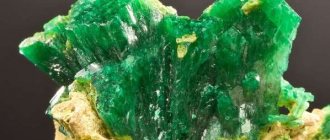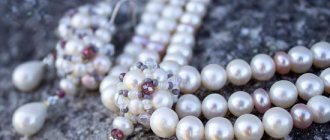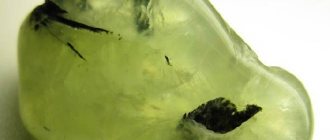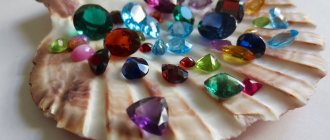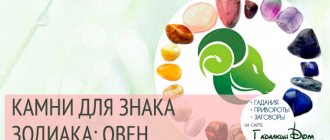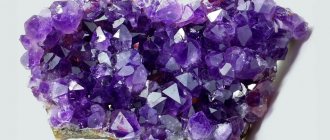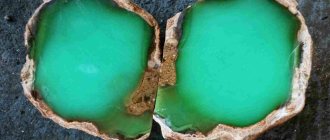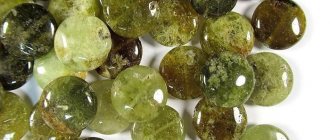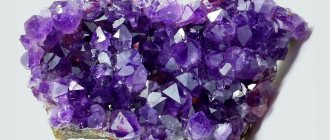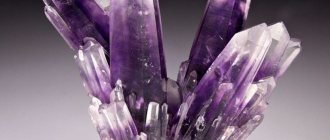| Stone type | Semiprecious |
| Prevalence (Deposits) | Austria, Brazil, Germany, Russia, North America, Sri Lanka |
| Varieties | Ametrine, brandberg, lavender amethyst, proselytes, rutile amethyst, chevron |
| Transparency | Transparent |
| Shine | Glass |
| Mohs hardness scale | 7 |
| Chemical composition | SiO2 |
| Color | Green, Pink, Purple, Black |
| Owner's color type | Summer |
| Owner's temperament | Sanguine, phlegmatic, choleric |
| Names | Andrey, Antonina, Arkady, Arseny, Valeria, Varvara, Venus, Violetta, Vsevolod, Denis, Dmitry, Evgeny, Elizaveta, Leonid, Lydia, Lyudmila, Maxim, Marina, Maria, Oleg, Regina, Renata, Roman, Semyon, Elvira |
| Zodiac sign | Gemini, Libra, Aquarius |
| Date of Birth | from May 21 to June 21 from September 23 to October 23 from January 21 to February 18 |
| Chinese horoscope | Rat, horse, tiger |
| Element | Air |
| Planet | Venus, Neptune, Saturn |
| Day of the week | Thursday |
| Month | February, December |
| Season | Winter |
| Numerology vibration | 3, 8 |
| Chakra | Ajna, Sahasrara |
| What stones is it compatible with? | Rock crystal, emerald, labradorite, moonstone |
| What stones is it not compatible with? | Beryl, malachite, sardonyx |
| Therapeutic effect (problems) | Insomnia, pain, spasms, vision, nervous disorders, stress |
| Therapeutic effect (on organs) | Organs of the gastrointestinal tract, hearing organs, cardiovascular system, joints |
| Magic properties | Spiritual development, energy depletion |
Green amethyst, or prasiolite, is a rare variety of quartz.
The stone attracts attention with the beauty of its shade. There is only one deposit of a unique mineral in the world, and it is located in Brazil. Therefore, stones mined from nature are not found in jewelry. For decorative purposes, quartz painted using a special technology is used. Natural green stone amethyst is a gem with powerful energy, manifested by magical and healing properties. There are also many legends associated with the beautiful stone that will interest many admirers of jewelry stones. When choosing products with a gem, take into account its energetic compatibility with the signs of the Zodiac.
Prasiolite or green amethyst - the history of the stone
Prasiolite stone owes its name to the leek for its green color and consists of two Greek words - “leek” and “stone”. “Onion stone”, in its color shade, closely interacts with nature, and today the existence and origin of this mineral is a mystery due to its rare occurrence. But, despite this, the stone is in great demand for making jewelry, since people have learned to make green amethyst using natural quartz as raw materials.
Proper care of green amethyst
Prasiolite can quickly lose color in direct sunlight, turning it into rock crystal.
There is a way to return the product to its original color using x-rays, but it would be better to just take good care of it.
From time to time, the stone is cleaned in soft, warm water and a mild soap solution. Use a non-hard toothbrush, flannel and other materials.
Despite the strength of amethyst, it should be protected from scratches, so it is stored either separately from other jewelry or placed in a bag.
Green amethyst stone - legends and myths
When exposed to special radiation, amethyst acquires a delightful menthol-colored hue, which allows it to be harmoniously combined with silver and gold. There are several stories, legends and myths about the amethyst stone, regardless of its color shade:
In Rus', in ancient times, there lived a pair of lovers - Afanasy and Anna. Afanasy was forced to go on a long trip, and disappeared in a foreign land without a trace. Inconsolable Anna lost the will to live from grief and melancholy and one day at dawn she disappeared without a trace. People who went looking for the girl found a scattering of magnificent amethysts. Since then, the gems have been nicknamed widow's stones, personifying love and fidelity.
Here, another legend - the god of wine in ancient Roman mythology, was angry because people did not glorify him enough. He gave the order to his tigers to tear to pieces the first person they met. The innocent victim of bloodthirsty predators was a peasant girl named Amethyst. The tigers tore the girl to shreds, and at the place where the monstrous murder took place, drops of blood remained, turning into noble amethyst crystals.
In the science of mineralogy, prasiolite is a type of quartz with a structure characteristic of this mineral. The hardness of the stone on the mineral hardness scale (Mohs) is 7 points. Therefore, the gem can scratch the glass without much effort.
Prices and best time to buy
The price of green amethyst, depending on whether it was found in the bowels of the earth or obtained by calcination of other quartz, will differ. The cost of natural specimens starts from $30 per carat, and natural analogues – $7–16.
It is better to purchase green amethyst jewelry on the 12th lunar day. They need to be brought home and placed with other jewelry. Only on the 26th lunar day is the gem worn for the first time.
Green amethyst is a rare stone, the reserves of which in the bowels of the Earth are almost depleted. Therefore, they learned to obtain it artificially from other quartz. This does not make gem jewelry any less beautiful, or their magical properties weaker.
If you have purchased green amethyst jewelry or used the gem for other purposes, please tell us about it in the comments. Share the article with your friends on social media. networks. All the best.
Where does the shade of the stone come from?
Natural amethysts owe their violet-pink color to the presence of impurities of manganese and iron. The green tint in nature is created by natural pigments of organic origin.
But such a combination happens very rarely, so people have learned to make artificial green amethysts. They are obtained by irradiation or by calcination of quartz or amethysts of other shades. Stones mined in Brazil or deposits in the states of Montezuma or Arizona (USA) are used.
When the temperature reaches +500 °C, the final color of the amethyst turns out to be onion or light green, lemon yellow, or emerald.
This entirely depends on the purity of the chemical composition of the raw materials and the precise execution of the procedure. The resulting material is also called prasiolite or green amethyst. Other names of stone:
- Most often it is emerald or green quartz.
- A rarer name is Indian emerald .
- Next come the names from the field of mineralogy - peridine, chrysoquartz and vermarine.
Green amethyst minerals are very rare in nature, so they are expensive.
Jewelers find such stones extremely rarely; they are increasingly found by true collectors and fans. All sorts of scammers and dirty businessmen are trying to sell processed minerals at higher prices, advertising their products as natural gems.
How to distinguish natural stone from fake
Fraudsters pass off colored glass as green amethyst. It is not difficult to distinguish a fake from a natural gem: just put it on your cheek and hold it for a few minutes. Natural green amethyst will remain cool.
Needle-like inclusions in a crystal are not a sign of a fake. In nature, there are specimens with such a defect.
Only professionals can distinguish a natural stone from an amethyst processed at high temperatures. This will require special equipment. The average person should understand that only natural analogues of green amethyst are widely available. Natural stone is used exclusively in expensive exclusive jewelry.
We recommend watching a video review about fakes:
Green relatives of prasiolite
Genuine green prasiolite is similar to the stones: beryl, peridot and tourmaline. But, in terms of color, they are more juicy and reflect light more strongly (shine).
As a type of amethyst mineral, according to the characteristics of the stone, aventurine and chrysoprase are placed on a par. This is a mistake: the presented gems, although green in color, are independent minerals.
Currently, the term "prazem" is used. It is not considered a mistake to apply it to any natural quartz that is grassy or onion green in color.
Green amethyst or prasiolite: what is the difference between these stones and each other?
In gemology there is still no clarity regarding prasiolite: some experts believe it is a green amethyst, others are more confident that it is one of the varieties of green quartz.
The quartz group also includes amethyst, known for its purple color.
The name “green amethyst” appeared in 1950 at the Montezuma mine in the state of Minas Gerais (Brazil). There, an artificial analogue of prasiolite was first obtained by heating amethyst at a temperature of 500 degrees Celsius. The artificial stone turned out to be more transparent and more durable than natural stone. Its color scheme can be of various shades of green.
Difficulties associated with identification
Since there is no mineral with the name “prasiolite,” the mineralogical nomenclature does not provide for the position of this stone. The name “prasiolite” was coined by the ancient Greeks for pebbles with a color similar to leeks: “prasios” - onion, “litos” - stone. Most likely it was greenish quartz.
Many believe that prasiolite is the name given to processed or genuine green amethyst mined from Brazilian mines.
Amethyst – stone of eternal love
Amethyst is the most beautiful stone, a symbol of lovers. Humanity knew about it in ancient times, using its properties to their advantage. The magic and healing power of the mineral made it a desirable material for all kinds of jewelry and objects. This is evidenced by archaeological excavations, which have provided evidence of the active use of amethyst for various purposes. In many cultures, this mineral was highly revered, considering it a valuable and useful acquisition.
Legendary Origin
One legend says that people stopped worshiping Bacchus, the god of wine. He decided to teach the infidels a lesson and severely punish the first person he met, so that everyone else would know what fate awaited everyone who refused to worship him. Bacchus unleashed his bloodthirsty dogs on the one who was the first to emerge from the forest. It turned out to be the young beautiful nymph Ametis, who was going to the temple of the goddess Diana. Seeing her imminent death, the nymph prayed to the goddess for help. Diana, in order to avoid tearing apart the young creature, turned Amethys into a snow-white sculpture. Seeing such dazzling beauty, Bacchus regretted his temper. He wanted to revive the nymph and spilled his red wine on the statue, like blood that would flow through its veins. But the miracle did not happen. Amethys remained motionless, only its color changed. Now it has turned deep purple.
The second legend tells that the god of wine, Bacchus, fell in love with the innocent nymph Ametis. But she was in love with someone else, and for this reason she refused her admirer. Bacchus was angry at the beauty’s refusal and decided that if she did not give herself to him of her own free will, he would take her by force. But the nymph resolutely stood her ground. Blinded by passionate desire, Bacchus tried to grab Amethys. The goddess Diana came to her aid. She took pity on the innocent creature and turned her into a statue of dazzling beauty. Bacchus, grieving over the loss, tried to revive his desired Amethys. He shed his wine tears in a stream, but the result remained the same - the nymph froze forever. The only thing that has changed is the color of the statue. She turned dark purple.
Since then, it has been believed that just as the nymph Amethys was able to resist the power and charms of Bacchus, the stone named after her can resist alcoholic beverages. Amethyst absorbs the power of alcohol, just as the statue of a nymph once absorbed the wine of the god, and prevents its owner from getting drunk. This ability of amethyst is a very great advantage and was widely used by the ancestors.
Description of the mineral
Amethyst is a type of quartz. Moreover, it is the most precious of its types. The color of the stone can vary from soft lilac to dark purple. The most valuable are rich, dark amethysts. Overall, this mineral is inexpensive. The reason for such cheapness is not so much that there are many places to quarry the stone, but rather the variety of artificial fakes.
Amethyst is a very durable mineral that cannot be scratched. The stone resists high temperatures. If you heat amethyst to 250 degrees, it will become discolored. But when it cools down, the color will return to it. But if the temperature is too high, about 350 degrees, the stone will lose its purple color and remain transparent forever. Amethyst also reacts in its own way to direct sunlight. Most often it brightens. But there are also types that remain unchanged.
The purple color of the stone is unevenly distributed throughout the mineral. One small pebble can be both light lilac and dark purple at the same time. This unusual coloring property has made scientists sweat. Some claim that the stone has a coloring substance. Others say that such a varied purple color is given to amethyst by manganese and cobalt, which are present in it to varying degrees as impurities. And still others are sure that the mineral has defects, which is expressed in its strange appearance and color.
No one has gotten to the bottom of the truth yet. But thanks to this unique type of amethyst, it can be distinguished from an artificial fake. Of course, people will soon learn to make ideal substitutes for natural minerals. But there is still a chance to acquire a real amethyst.
How to recognize a fake?
Real amethyst:
- has an uneven color;
- slightly cloudy;
- takes a long time to heat up in the hand;
- has a heterogeneous structure (there are various stripes and inclusions in the stone)
Fake:
- has an even color tone;
- it has high transparency, there is no turbidity, which is inherent in quartz;
- if you hold it in your hand, it heats up quickly;
- it has a homogeneous structure
Thus, you can understand that a fake will seem too perfect and unnatural. If you have any doubts about the originality of the stone, you can immerse the amethyst in water. The fake will remain unchanged, but the real mineral will be slightly discolored around the edges. If you yourself have not been able to figure out the authenticity of an amethyst, then it is better to turn to a specialist in your field - a jeweler. It will help dispel groundless doubts or confirm a guess.
Variety of names for amethyst and its uses
Amethyst was called the “royal stone”. The reason for this was the wearing of a crown with large amethyst stones by the Russian Tsarina Irina Godunova. In Catholicism it was known as "bishop's". This is due to the fact that spiritual officials wore rings with amethyst. Such a ring was a symbol of purity and justice. Over time, jewelry became available not only to high officials, but also to ordinary people. Amethyst brought peace and harmony to the owner's family. It is not for nothing that Tibetan monks believed that this stone helps to achieve the highest enlightenment. It was called the “Buddha stone” and rosaries were made from it. Amethyst opens a person’s vision of the full picture, helps to solve complex problems, and emerge victorious from any difficulties.
The Egyptians considered amethyst a powerful amulet for long journeys. And if the trip is connected with commercial transactions, then the power of the mineral will be doubly manifested, because amethyst preserves and increases material wealth. Many merchants carried a piece of stone with them to protect their ship from robbery. The ancient Greeks had their own opinion about amethyst. They called him "not drunk." This is connected with the legend of the nymph and god of wine, her opposition to the charms and wine streams of Bacchus' tears. In Greece, it was customary to drink wine from cups made of amethyst to avoid getting drunk. If there was no such vessel, a couple of mineral pebbles were placed at the bottom of an ordinary glass. In this way, people protected the body from the harmful effects of drinking.
The magic of amethyst and contraindications to its use
Amethyst has always been a symbol of purity and innocence. He carries only goodness and eternal love. A talisman made from this mineral has great properties that can cleanse its owner from negative energy. But the stone cannot be constantly loaded with only negative energy flows. Otherwise, it may act opposite to its purpose. If an amethyst is constantly imbued with negativity, then it will bring evil, not good, into the owner’s life; difficult and hopeless situations will be attracted more often. Amethyst has no contraindications for zodiac signs, although some experts are trying to convince people that this mineral should not be worn by Taurus and Leo. In fact, the stone may not suit any zodiac sign. For amethyst, only the spiritual aspect, the hidden thoughts and desires of the owner are important. If a person turns out to be evil and unkind, then the mineral will not help him. And if he is worthy, then all the magical and healing properties of amethyst will manifest themselves with great power. The lighter and purer the owner’s soul, the longer the talisman will serve for good.
In general, we can highlight the main abilities of the mineral:
- Cleansing the soul from the negative impact of the surrounding world.
- Cleansing the body from diseases.
- Getting rid of intoxication and alcohol addiction.
- Eliminate fear before important events.
- Increase in material wealth.
- Protection from the machinations of enemies who are trying to harm family relationships.
- Help in acquiring wisdom, peace of mind and peace of mind.
Amethyst is useful for children to have with them. They are still pure and innocent. The stone will give the child all the good character traits and will be a reliable defense against enemies. The mineral will have a beneficial effect on life situations, attract good luck in life, and help you express yourself. It will also give its owner confidence in his abilities. Amethyst is a stone of life happiness. It is good to have such a talisman with you before exams, for example, or an important conference. This will help you stay focused. It is useful to have a talisman stone for those who are looking for a career advancement. Amethyst has a beneficial effect on negotiations and everything related to financial wealth.
One of the main magical properties of amethyst is its influence on family relationships. Long ago, it earned the name “widow’s stone.” This is due to the fact that women who lost their husbands began to wear rings with amethysts. This was evidence of their eternal love, showing that no one else could win a woman’s heart. Such widows remained alone forever, without forming relationships with other men. After all, wearing an amethyst ring was akin to an oath of marital fidelity before God.
It is believed that amethyst helps to find a strong relationship with a loved one. If a wife gives her husband this stone, then no one will be able to break up their couple. At the same time, such gifts from the outside should be avoided. After all, if someone gives one of the lovers an amethyst gift, they will attract love to themselves, thereby destroying family relationships.
Healing properties of the stone
One of the most important healing properties of amethyst is the fight against alcohol addiction. People have always believed that they would not be able to get drunk by drinking wine from a glass containing a piece of this mineral. And if you carry an amethyst amulet with you constantly, you can even get rid of alcoholism. The craving for drinking will gradually fade away, and over time, an aversion to alcoholic beverages will even appear.
Amethyst also helps get rid of many diseases. Most often, the stone was used like this: put it in a vessel with water, let it sit overnight, and in the morning the sick person drank this water. In this way, amethyst cleansed the body, destroying infection and healing internal organs. There is an opinion that the Romans dipped amethyst into the bowl not only to charge the water with healing powers, but also to destroy the effect of the poison. They believed that the stone purified the drink by absorbing any kind of poison.
An important fact is that the mineral helps get rid of pain. You just need to put the amethyst on your head (or any other place that hurts) and feel the healing effect of the stone.
There are many pieces of jewelry that help in the treatment of many diseases. For example, to strengthen the immune system, you need to wear an amethyst ring, and amethyst earrings are perfect for improving vision.
If you thoroughly understand the properties of this wonderful mineral and establish a relationship with yourself, then amethyst will become a wonderful amulet for life. You just need to remember that you need to properly care for your talisman: you need to periodically rinse it under running water for several minutes and do not leave it in places exposed to sunlight. Then the amethyst will last for a very long time, bringing happiness to the family. Amethyst does not like quarrels and scandals, so you should not wear jewelry with it in such situations so that it does not absorb the destructive power of negativity.
Peace, tranquility, luck, love, joy, unconditional happiness - this is what awaits a person who has an amethyst with him. This ideal stone makes people like itself. All that remains is to open your soul to magical cleansing.
Places of mineral extraction
Prasiolite is a rare occurrence in nature.
Green stones were previously mined in Brazil, in the mines of the Republic of South Africa, and distant Australia. The mineral was also available in European countries - Poland and Germany. Today, its reserves have dried up, but you can probably find light green amethyst in Russia; olive-colored stones exist in the United States of America and India, with a more saturated tone. More recently, new deposits were discovered in Brazil. The mineral there is open yellow-green in color and has a characteristic structure that is much different from the generally accepted structure.
History and origin of the mineral
Green amethyst is a stone with an interesting story. It says that Catherine II owes much of her achievements in the political sphere to jewelry with a mystical green amethyst.
In the eighteenth century, the Grand Empress received a brooch with natural amethyst as a gift from the Polish king and the Grand Duke of Lithuania. Catherine II liked the jewelry with the mint stone so much that she wore it every day to important negotiations and wore it until her death.
Green amethyst minerals were discovered several thousand years ago. Even the ancient Greeks used them in jewelry and magical amulets, calling them onion stone and crystal of illusion.
Over the hundreds of years that the stone has been known to mankind, it has been called differently:
- emerald quartz;
- peridine;
- Indian emerald;
- vermarine.
Despite variations in its names, the mineral has nothing in common with emerald. These minerals have different chemical formulas and compositions.
Green amethyst - physical properties
Prasiolite is one of the rare varieties of quartz. It has a rich range of green colors, rich in various nuances and shades: from pale gray-green to grassy, and leek... Direct exposure to sunlight discolors the color of the stone, making it transparent.
- Chemical name (formula) - SiO2.
- Color: onion-green leek.
- The shine is glassy, and at different lighting angles it is pearlescent.
- Transparency - transparent or semi-transparent.
- Hardness - 7.
- Density - 2.65 g/cm3.
The crystal form is a hexagonal prism. Natural stone is relatively fragile. Externally it is similar to tourmaline, beryl, and peridot.
Colors and varieties of gems
In the early fifties, jewelers from America tried to change the shade of amethyst quartz rock. Under the influence of high temperature, the transparent mineral began to acquire a green tint, and thus prasiolite was obtained.
Considering the method of obtaining the shade, it should be noted that the crystal can have a wide range of colors:
- green, ranging from light to dark green,
- leek onion color,
- olive color,
- lemon shade,
- emerald color, not inferior to natural emerald.
The variety of tones depends not only on the method of calcination of the rock, but also on the original quality of the mineral.
The gem is calcined and then cooled in a dye solution of the desired shade. The sudden change in temperature causes microscopic cracks in the surface of the quartz, into which the dye penetrates, changing the color of the stone.
After heat treatment, the stones become stronger than natural ones and do not fade from direct exposure to sunlight.
The next method is ionized irradiation. Craftsmen from South Africa were good at this method. As a result of this irradiation, gems shine in various shades, such as emerald, pastel green, lemon and mint. The final color depends on the color of the raw material before irradiation.
Deposits and methods of obtaining green amethyst
Green amethyst is highly valued by jewelers.
The gem is mined in different parts of the world. In each country it has its own shade:
- Russian deposits are characterized by almost transparent light green stones;
- Brazilian minerals are distinguished by a mint shade;
- in India there are amethysts with a delicate olive tone;
- Crystals mined in the USA have a vibrant, fresh green hue.
A few decades ago, deposits were also known in Italy, Switzerland and Mexico, but today they are considered completely depleted.
The ancient Aztecs noticed that amethyst changed its properties when exposed to high temperatures. If you take a light, almost transparent gem and heat it, it will acquire a greenish tint. In India, to obtain an unusual color, mined stones were left for several days under the bright tropical sun. Russian ore miners discovered their own know-how: they put dim gems into dough and baked them like bread.
By the beginning of the 20th century, when the demand for prasiolites far exceeded the supply, the production technology was improved. To obtain green crystals, natural amethyst, quartz or citrine were calcined at a temperature of 500°C. In the 50s last century, they also mastered the processing of stones with ultraviolet radiation.
Using various techniques, increasing or decreasing the temperature, using UV rays, crystals of various shades are obtained: mint, grass-green, emerald.
Green amethyst - healing properties
Since ancient times, people, based on centuries-old practice, have attributed healing properties to noble stones that serve as jewelry. Green amethyst is often used to get rid of viral diseases. To eliminate malaise, chills, or elevated body temperature, you need to hold an emerald-colored mineral in your hands. In less than an hour you will feel a positive change in your health.
Green amethyst is successfully used to relieve headache attacks. For this purpose, bracelets or rings made from this breed are used. The jewelry is alternately applied to the temples, and after 15 minutes the headache begins to subside until it stops completely.
In case of hearing loss or deterioration in visual acuity, it will be useful to wear green amethysts, placing them near the head. For a healing effect, the gem must have contact with your skin. Applying it to a sore spot through clothing will not have a healing effect. Women wear earrings or hairpins made with green amethyst. Men can wear pendants or chains with this healing breed.
Appearance of the mineral
According to the geological group, the gem belongs to quartz, like its fellow rock crystal and citrine. The stone is classified as semi-precious and is widely used in jewelry making.
Color and structure
Natural gems can be of very different colors - from soft green, almost transparent, to rich emerald. The most common color among natural and artificial minerals is onion green.
The gems have a soft green color.
When exposed to light, the crystals are transparent or translucent. The refractive index varies between 1.54 and 1.55. On the Moss scale, which determines density, “onion amethyst” scores 7 points out of 10. The stone has a moderate glassy luster; it is brittle and conchoidal when fractured.
How to distinguish from prasiolite
Gemologists still cannot come to a consensus on what prasiolite is. Some identify it with natural onion-colored amethyst, while others call it a greenish variety of quartz. Still others call gems that have undergone heat and ultraviolet treatment prasiolite. Because of this confusion, it can be difficult to decide which mineral is inserted into the jewelry, green amethyst or prasiolite, and how to distinguish one from the other.
Natural green amethysts are extremely rare, are counted in pieces, and their price is unusually high. Only mineralogy experts can distinguish a gem with a natural color from a processed one in laboratory conditions. But most often in jewelry they use stones whose green color is due to the use of high temperature and ultraviolet radiation.
They also cannot be called artificial, because a natural mineral is taken as the basis for obtaining such prasiolite.
Prasiolite in cosmetology
To restore and rejuvenate facial skin, a massage using a mineral is considered successful. A series of sessions will help get rid of acne, age spots and wrinkles. It is recommended to wear jewelry with green crystal for those who have diseases of the circulatory system or heart problems.
Since the energy of this crystal is quite powerful by nature, there are a number of diseases that prohibit the impact of jewelry when worn. These are people suffering from mental disorders and depressive tendencies. Exposure to the mineral can worsen the patient’s condition and cause an exacerbation of the disease. If there are no such mental deviations, then the mineral will only improve the functioning of the brain, thereby improving the general condition of the body and its performance.
The effect of the mineral on the body
Green stone embodies its natural powers, therefore it has the following healing properties:
- When body temperature rises, it helps reduce fever until it disappears completely.
- Products with prasiolite should be worn in case of diseases caused by pathogenic bacteria and viruses of various origins.
- As practice has shown, pathogenic microorganisms die from the powerful energy of onion stone.
- Green-colored gems normalize heart function and the condition of the vascular system.
- The stone successfully treats and reduces headaches.
- The gem effectively improves visual acuity and relieves eye fatigue.
- The mineral effectively helps fight signs of aging of the facial skin. Washing with water infused with crystals is useful.
Who is the mineral suitable for?
The gem favors creative individuals: artists, writers and poets, musicians, scientists and speakers. Of those for whom the mineral is suitable, it is worth highlighting politicians. Their speeches will become more convincing thanks to the properties of the crystal.
Jewelry should be worn by business people.
Business people are advised to carry a raw gem or jewelry with it during important negotiations. The mineral promotes success in business. Subordinates who have angered their superiors should take a crystal with them when called to the carpet. It will protect you from unfair reproaches and help you avoid too severe punishment.
In a family, the stone helps maintain good relationships. If there are decorations with prasiolite in the house, this will protect spouses from quarrels, and parents and children from conflicts and misunderstandings.
How do jewelry with green amethyst affect your health?
The magical properties of jewelry are enhanced if prasiolite is in silver. In this case, different decorations have the following effects on a person.
- Bracelet: helps you organize your personal life and become a successful person.
- Ring: will relieve you from painful thoughts. Helps improve your financial condition and set you up for an optimistic outlook on life.
- Pendant: successfully treats suffering caused by unrequited love.
- Necklace: will protect you from ill-wishers and envious people.
- Earrings: will eliminate sad thoughts and despondency.
When choosing silver jewelry as a talisman, carefully listen to your feelings. If the stone you are trying on is pleasant to wear, then it is suitable for you and will bring the expected benefits.
Mystical properties of amethyst
The magical properties of the amethyst stone are manifested in its ability to bring prosperity and abundance to the owner. The spoken stones renew feelings of love and passion in a couple who have been living together for a long time.
Excessive use of pebbles in everyday life can have a negative impact on you and others. In such cases, abuse can provoke negative consequences.
Green amethyst is a stone that can warn its owner of impending changes for him. Changes can be pleasant, or they can warn of possible danger. To improve the positive qualities of the stone, it should be worn with a cross, preferably made of silver, but not gold.
Rings made from amethyst can attract wealth and prosperity to the owner, and earrings relieve melancholy and despondency and give confidence in their actions. The owner who wears the pendant will feel protection from negativity, love from loved ones, and care for himself.
Magic properties
The magic of the stone helps a person improve his life and reveal the best qualities of his character. This gem represents peace, friendship and tranquility.
The magic of jewelry
The magical properties of prasiolite are clearly manifested if the mineral is inserted into a frame made of white gold or silver. Pendants with gems are reliable helpers in your personal life. If a person wants to get rid of depression, it is better for him to wear earrings with a green stone. The ring is a reliable talisman that will help bring material well-being into life.
Talismans and amulets
Features of using amulets with green amethyst depend on what goals a person wants to achieve. It is useful to place products made from prasiolite in the bedroom, as they will protect sleep. Gold jewelry with a gem is a talisman that will protect the union from betrayal.
If a person is facing a fateful conversation, it is better to put a prasiolite stone in the pocket of a shirt or jacket.
What signs is amethyst suitable for?
Prasiolite, according to astrologers, is suitable according to the horoscope for all signs of the zodiac, but its most likely compatibility is with:
- Aries;
- Pisces;
- Sagittarius;
- Aquarius.
People belonging to these zodiac signs will feel the positive influence of the gem:
- anxiety and worry will disappear;
- peace of mind will appear;
- there will be an improvement in well-being;
- the person will become more active, able to withstand emotional stress.
Other zodiac signs can count on the fact that prasiolite will also bring them a lot of benefits. The magic of a wonderful stone will help their owners become more confident in their abilities and promote spiritual growth.
The main significance of prasiolite for a person is that he selflessly shares his positive energy. All of these listed properties that have a positive effect on a person will be present if the jewelry worn is made of natural stone. When purchasing a product with a green stone, you should be extremely careful to distinguish a fake from a natural amethyst. Only genuine stones have magical properties. Counterfeits will not benefit their owner.
How to distinguish a real green amethyst from an artificial one?
It is difficult for a non-professional to distinguish between synthetic and real green amethyst, even if you carefully study all its properties and look at the photo before going to a jewelry store. For this you need to have special equipment.
However, regardless of origin, natural and artificial prasiolites look equally beautiful.
Their main difference is the price; yellow quartz, from which green amethyst can be made, is an inexpensive raw material. Also, the saturation of the color may indicate that the product is not real.
Prasiolite is not the most expensive stone, its name is:
- Indian emerald;
- emerald quartz;
- peridine;
- chrysoquartz;
- green quartz;
- vermarine.
Interestingly, due to its attractive appearance and good quality, in ancient times they liked to sell it under the guise of tourmaline or emerald.
How to wear and care for jewelry
Green amethyst can fully reveal and retain its healing abilities, as well as its beauty, provided that the jewelry is worn and cared for correctly.
- It is necessary to protect the mineral from exposure to direct rays of the sun, protecting it from discoloration.
- All kinds of chemicals used in everyday life, as well as cosmetics, can cause damage to jewelry.
- To clean the product, use only soapy water and a soft cloth.
- Amethyst is a hard crystal, but can be scratched by metal upon direct contact.
Amethyst is not intended for constant wear; the jewelry should be combined on special occasions and holidays with clothes chosen to taste and other accessories with a cool palette of shades.
